Seals
Seals are among the most visible denizens of the Arctic. In the following, we will describe seven indigenous seal species that live on the sea ice. All of these species belong to the earless seals. Some of them use the sea ice year-round (ringed seals, bearded seals and walruses), while others occasionally leave the Arctic ecosystem (harp, hooded, spotted and ribbon seals) and migrate farther south (subarctic seals). Grey seals and harbour seals can also be found in the waters of the Arctic. However, since they only come into contact with sea ice in a handful of areas, they will not be discussed here.
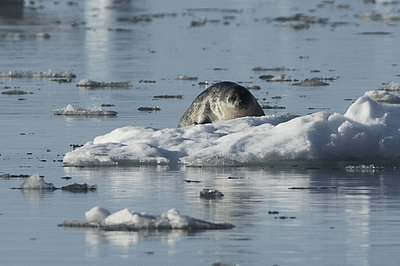
Pusa hispida
The ringed seal is the seal species with the largest distribution in the Arctic Ocean. At the same time, it is the smallest Arctic seal species and the only one in the northern polar sea capable of maintaining its own breathing holes in the sea ice, using the powerful claws of their foreflippers to scrape away at the ice cover. As such, it is perfectly adapted to polar conditions, which helps to explain its dominance up to the North Pole. The current ringed seal population is estimated at several million. However, very little information is available on the sizes of the regional subpopulations (Laidre and Regehr, 2017).
Generally speaking, ringed seals are mainly found in regions characterised by seasonal ice, and less frequently in the regions of the High Arctic near the North Pole or north of Greenland, which are home to multiyear ice. Presumably, it’s easier for them to keep their breathing holes open in thinner ice. Ringed seals are heavily reliant on sea ice, since they need a solid surface for their resting phases.
Moreover, the sea ice is the only place they can breed and rest. Ringed seals prefer fast ice in fjords and along the coast, which is relatively thick and topped with stable snow cover. This is where, in the early spring, they make caves for birthing and rearing their young. Sufficient snow cover, stable ice and low temperatures are vital to the breeding success of ringed seals. They have the longest lactation period (nursing time) of all northern seals, and give birth to and nurse their young on the ice (Blanchet, 2014). At birth, ringed seal pups weigh roughly four kilogrammes, which is why they need sufficient warmth in their snow caves. In addition, the caves offer protection from polar bears, Arctic foxes and other predators. As such, a lack of snow on the ice, or high spring temperatures and spring rains, can drastically reduce their breeding success.
In summer, ringed seals live in the open water, though they remain linked to the sea ice throughout the year, as they feed on animals found on the ice. The ringed seal’s diet is diverse and varies both regionally and seasonally. In turn, the ringed seal itself is an important prey species for polar bears.
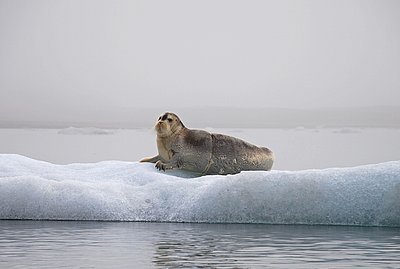
Erignathus barbatus
Bearded seals can be found throughout the circumpolar Arctic, and were given the name because of their conspicuous, long white whiskers. They chiefly live in the shallow waters of the continental shelves, tend to avoid thick pack ice without access to open water, and are mainly considered to be coastal animals. They normally remain close to open water, especially on drifting pack ice, where leads and polynyas offer them escape routes and breathing holes, and where polar bears, their natural enemies, are less likely to hunt them down. They can only be found on thick pack ice if there are patches of open water. In summer and autumn, they mainly live in the open water, though they remain near the sea-ice margin throughout the year (Laidre and Regehr, 2017). When it comes to rearing their young, and to moulting in late spring or early summer, they rely on stable seasonal ice.
Their year-round habitat on the drifting ice of the shallow coastal regions offers the animals, which can dive to depths of 220 metres, ample food. They feed on organisms living on the seafloor, which they use their whiskers to help find, such as crustaceans, bivalves and snails, as well as smaller fish (Blanchet et al., 2014).
In regions where the ice has completely disappeared, the seals rest and moult on land. As a rule, bearded seals are solitary animals. However, during breeding and moulting periods in late spring or early summer, they often form small groups.
The current bearded seal population is estimated at between 500,000 and 750,000. In this regard, experts differentiate between two subpopulations: the Pacific bearded seal (E. b. nauticus), which can be found from the eastern Laptev Sea to the central Canadian Arctic, as well as the Sea of Okhotsk; and the Atlantic bearded seal (E. b. barbatus), which can be found from the central-east Canadian Arctic to the central Eurasian Arctic (Laidre and Regehr, 2017).
Odobenus rosmarus
The largest seal species is the walrus, which can be found throughout the Arctic. Walruses need patches of land or ice to rest on near their feeding grounds. They often overwinter in regions with polynyas, which afford them access to the water and their food sources. There are two different walrus species – the Pacific walrus (Odobenus rosmarus divergens) and Atlantic walrus (Odobenus rosmarus rosmarus) – in the Arctic
In winter, the Pacific walrus lives on ice floes on the shallow continental shelf in the Bering Sea, which offer them easy access to the water and to their food sources on the seafloor. When the ice gradually retreats in spring, the females and their young migrate northward from the sea-ice edge to the Chukchi, East Siberian and Beaufort Seas. The majority of the males remain in the south and use the Russian coasts of the Bering and Chukchi Seas – and occasionally the coast of Alaska – as platforms for resting, presumably because they offer good access to suitable food sources. In autumn, the females and their young migrate back south to re-join the males. The current Pacific walrus population is estimated at 129,000 (Laidre and Regehr, 2017); that of the Atlantic walrus, at 20,000, is substantially smaller. The animals live both on the sea ice and on land. However, in summer the majority of them rely on the sea ice as a solid surface to rest on (Laidre and Regehr, 2017).
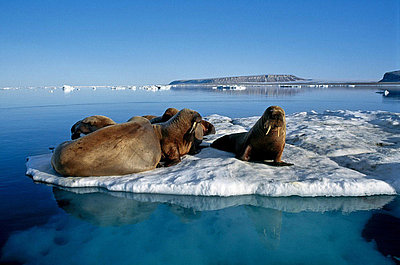
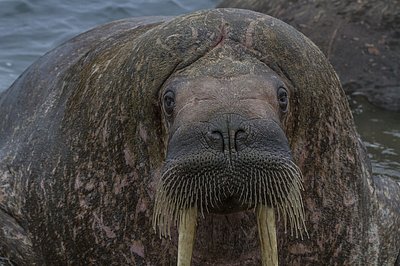
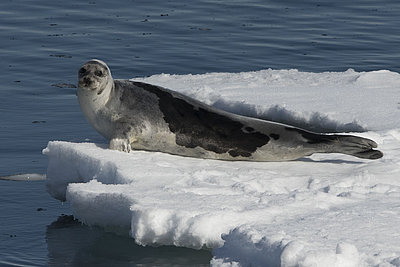
Pagophilus groenlandicus
No other seal population in the Northern Hemisphere rivals that of the harp seal: an estimated nine million. This substantial population is divided among three major regions: firstly, the coasts of Labrador and Newfoundland with the Gulf of St. Lawrence; secondly, eastern Greenland north of the island Jan Mayen; and thirdly, the White Sea east of Murmansk. Harp seals are closely linked to the sea ice. Females give birth on the ice, and all harp seals spend their moulting phases there. That being said, the seals also spend extended periods in the open water. They also live in the subarctic zone and warmer waters near the Faroe Islands, Barents Sea and European North Sea. Harp seals prefer the shallow waters of the continental shelf, where they normally dive to depths of less than two hundred metres for their food (Laidre and Regehr, 2017).
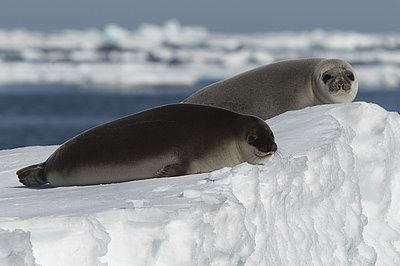
Cystophora cristata
The lifestyle of the hooded seal is similar to that of the harp seal; it can also be found in the North Atlantic, and also depends on stable patches of sea ice for giving birth and moulting. Further, in the ice-free months, it can also be found in subarctic waters. In some cases, hooded seals have even been spotted on the European coast and the East Coast of the United States. Hooded seals can dive to depths of up to 1,000 metres. Experts differentiate between two subpopluations, one in the northwest Atlantic (more than half a million) and another in the northeast Atlantic (ca. 82,000) (Laidre and Regehr, 2017).
Phoca largha
In the North Pacific, the spotted seal can be found in the Sea of Japan, Sea of Okhotsk, Bering Sea, Chukchi and Beaufort Seas. Spotted seals aren’t quite as closely linked to the sea ice as other seal species and have demonstrated considerable flexibility in terms of using it as a habitat. Fundamentally speaking, they prefer the sea-ice edge or smaller floes. In summer, some of them follow the sea-ice front to the coasts of the Chukchi Sea or the western Beaufort Sea. When the sea-ice extent grows again in October, they migrate south. In winter and spring, spotted seals utilise a large area extending up to 300 km north of the sea-ice edge in the eastern Bering Sea. They use pack ice and drifting ice for breeding and, depending on the region, give birth to their young there between February and May. They feed on both pelagic and benthic fauna like fish, crabs, other crustaceans and octopi. Though little is known about the total spotted seal population, it is estimated at ca. 200,000 (Laidre and Regehr, 2017).
Histriophoca fasciata
In the North Pacific, the distribution of the ribbon seal is similar to that of the spotted seal. It can also be found in the Sea of Okhotsk and the Bering, Chukchi and Beaufort Seas. Further, it also uses the sea-ice front from winter to spring, to give birth to and rear its young. In summer and autumn, it primarily lives in open water. Its main food sources are fish and invertebrates like cephalopods. There are an estimated 200,000 ribbon seals.
Blanchet, M.-A., M. Aquarone & U. Siebert (2014): Arktische Robben und Eisbären – Auswirkungen von Klimaerwärmung und Ressourcennutzung, In: Lozán, J.L., H.Grassl, D.Notz & D.Piepenburg (2014): WARNSIGNAL KLIMA: Die Polarregionen. Wissenschaftliche Auswertungen, Hamburg. 376 Seiten. ISBN: 978-39809668-63, pp. 183-191
Laidre K. & E. V. Regehr (2017): Arctic marine mammals and sea ice, In: D. N. Thomas (ed.), 3rd edition, Wiley-Blackwell, Chichester (UK) Hoboken (NJ), pp. 518-521
The only mammals that live in the Antarctic are seals and whales. The majority of Antarctic seals belong to the earless seals. For the Weddell seal (Leptonychotes weddellii), crabeater seal (Lobodon carcinophaga), leopard seal (Hydrurga leptonyx) and Ross seal (Ommatophoca rossii), life is closely bound to the sea ice. The southern elephant seal (Mirounga leonina) and Antarctic fur seal (Arctocephalus gazella) give birth to their young along the coasts of the Antarctic and subantarctic islands and, depending on the season, venture from there to the sea-ice-covered areas of the Southern Ocean in search of food. There are substantial differences between these seal species.
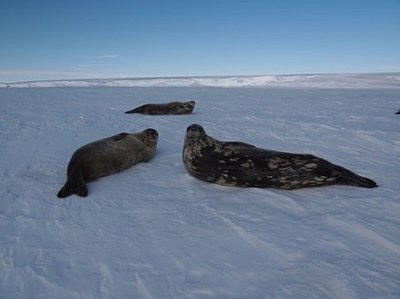
Leptonychotes weddellii
The Weddell seal populations are concentrated on the circumpolar, coastal fast ice of the Antarctic. The animals frequent the natural cracks, leads and holes in the ice, which they keep open in winter with the help of their teeth. Weddell seals can reach lengths of up to 3 metres and weigh up to 550 kilogrammes, with a lifespan of ca. 20 years. The females are somewhat larger than the males. According to estimates, there are between 800,000 and 1,000,000 Weddell seals (Thomas and Terhune, 2009).
Depending on the latitude, females bear their young in the residual fast ice between September and November. They nurse their young for 7 to 8 weeks; this is followed by the mating season. From roughly mid-January to early March, their fur moults. The animals are comparatively sedentary and usually find their food, mainly fish and squid, in a radius of ca. 50 to 100 kilometres from the fast ice. However, some animals go much farther and follow the spread of the pack ice in winter. During mating season in the early southern summer, Weddell seals form loosely associated groups of up to several hundred on the coastal fast ice, either along pressure ridges or near openings in the ice, which are formed by the tides and offer them access to the ice and water alike. Especially in summer, the seals rest for a few hours on the ice following every dive. On large floes, one can occasionally find lone animals, sometimes small groups, and rarely larger assemblies of up to 60 (Bester et al., 2017). Weddell seals can dive to considerable depths, including record dives of up to 80 minutes and 600 metres . As a rule, however, they go to depths of between 100 and 300 metres (Bester at al., 2017).
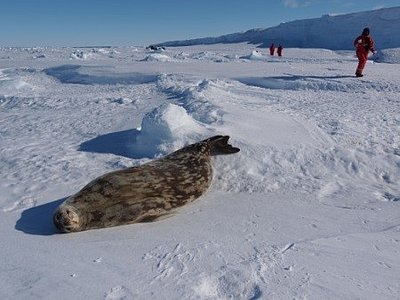
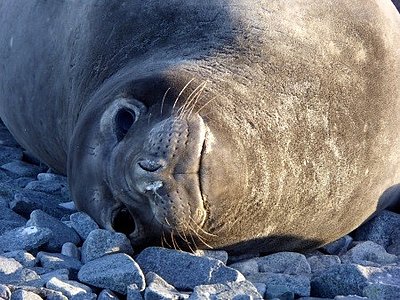
Lobodon carcinophaga
The crabeater (Lobodon carcinophaga) can be found throughout the Antarctic continent. The seal species is chiefly associated with the pack ice and, in the course of the year, follows it. Since the ice extent is lower in the southern summer than in winter, the seals are more likely to be found near the coast in the former than in the latter (Bester et al., 2017).
Depending on the region, pups are usually born between October and December; this is followed by the mating season from December to early January. From January to February, and occasionally to March, crabeater seals’ fur moults. Though they tend to be loners, occasionally they can be found in small groups and rarely in large ones of up to 30. In the water, they often form small groups. However, observations of groups numbering up to 500 have also been reported (Bester et al., 2017).
As a rule, crabeaters can reach lengths of up to 2.7 metres and weigh more than 200 kilogrammes, though extremely large specimens can weigh up to 400 kilogrammes. As is the case with Weddell seals, female crabeaters are larger than males. Crabeaters’ maximum lifespan is ca. 40 years; the average is 20 to 25 years (Bester et al., 2017).
The seals go for short dives of roughly five minutes, in which they reach moderate depths of between 40 and 140 metres. However, experts have also confirmed extreme dives of more than 700 metres (Bester et al., 2017). The dive depth especially depends on the availability of their prey species, which rise and sink in the water column in the course of the day. These species especially include the Antarctic krill, which makes up the majority of its food and is the reason for the species’ name, even if inaccurately (since krill are a shrimp species, not crabs). Crabeaters’ mouths are uniquely adapted to their food sources; their specially evolved, lobed and interlocking molars allow them to filter the crustaceans from the water. Similar to whales’ baleen plates, these teeth are filter-like. As a result, water is pushed out between them, while krill are trapped inside. There are anywhere between 7 and 15 million crabeaters in the Southern Ocean (Bester et al., 2017), making them the most common seal species in the world.
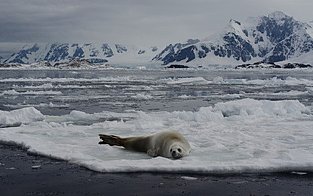
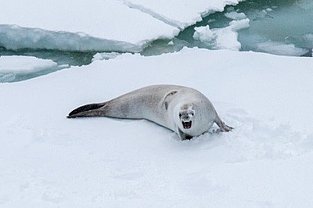
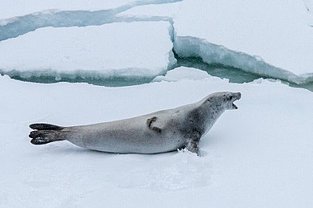
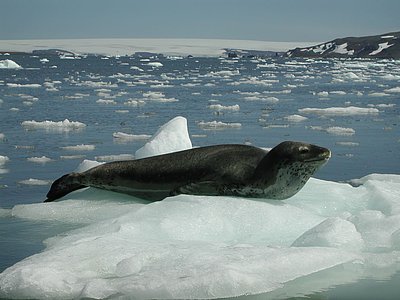
Hydrurga leptonyx
Like the Weddell and crabeater seals, the leopard seal (Hydrurga leptonyx) can also be found across the Antarctic continent. Its habitat is found at the edge of the pack ice. When the ice expands, some leopard seals follow the pack-ice edge north. In the course of this winter migration, they often stop to rest on the coasts of the subarctic islands. Depending on their location, females bear their young on the pack ice between October and mid-November. This is followed by the mating season from December to early January; moulting takes place in January and February. Though leopard seals are generally solitary in nature, groups can be found near large penguin colonies (Bester et al., 2017).
Leopard seals can reach lengths of up to 4.5 metres and weigh up to 600 kilogrammes. Females are larger than males. Their maximum lifespan is ca. 25 years (Bester et al., 2017). The leopard seal population is estimated at between 220,000 and 440,000 (Bester et al., 2017). Unlike the other Antarctic seals, leopard seals only dive in the upper water layers, at depths of between 10 and 50 metres, only occasionally diving down to 200 metres (Bester et al., 2017). One of the leopard seal’s physical hallmarks are its nostrils, which are situated atop and just behind its muzzle; those of the other earless seals are forward-pointing. Presumably, the leopard seal’s unique dental morphology is due to its ability to feed on both larger and very small prey species. All of its teeth are very large. Its sturdy canines and incisors are suited to seizing and tearing apart larger prey. Its molars are similar to those of the crabeater, allowing it to filter krill, which make up roughly half of its diet, from the water (Hocking et al., 2013; Bester et al., 2017).
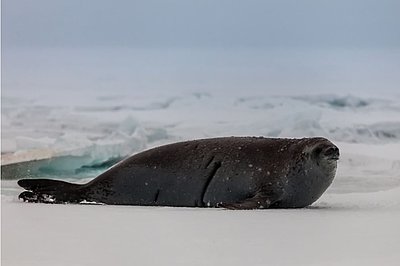
Ommatophoca rossii
The Ross seal (Ommatophoca rossii) is another species that lives on the Antarctic pack ice. The largest concentrations of this, the rarest Antarctic seal species, are to be found in the Ross Sea, King Haakon VII Sea and western Weddell Sea. The seals grow to between 2 and 2.5 metres in length and weigh up to 200 kilogrammes. Their normal life expectancy is over 20 years (Bester et al., 2017).
Depending on their location, Ross seals bear their young between mid-October and November. The mating season follows soon after, from December to January, with the exact timing depending on local conditions. The seals moult between December and early February. Once they’ve moulted, the adults migrate north and live in the open water to the south of the oceanic Polar Front, before heading back south into the pack ice in October to bear young again (Bester et al., 2017).
Throughout the year, Ross seals dive up to 100 times a day, at depths of between 100 and 300 metres and for durations of 5 to 15 minutes. The deepest dive recorded was nearly 800 metres (Bester et al., 2017). Ross seals have comparatively large eyes, which help them find food in the ocean depths. They have small, sharp and conical teeth, which they chiefly use to seize squid. Ross seals are primarily loners, but sometimes form small groups or, occasionally, larger ones. The current Ross seal population in the Antarctic is estimated at between 130,000 and 220,000 (Bester et al., 2017).
Mirounga leonina
Unlike the pack-ice seals, both southern elephant seals and fur seals bear their young along the littoral zones of the subantarctic islands and the ice-free shoreline areas of the Antarctic Peninsula. There are large populations near the Valdes Peninsula, Argentina, off South Georgia, and near the Kerguelen Islands, Heard Island and Macquarie Island. Other populations can be found off the Prince Edward, Crozet, South Shetland, South Sandwich and South Orkney Islands (Bester et al., 2017). As such, the southern elephant seal can be found throughout the circumpolar Antarctic. Females can grow to 2.8 metres in length and weigh up to 900 kilogrammes. Males can grow to 5 metres in length and weigh up to 5 metric tons, reaching ages of ca. 20 years. The total population is estimated at ca. 600,000 (Bester et al., 2017). Young are born between late September and early November. During mating season and moulting, southern elephant seals gather in large colonies. The southern elephant seal is an excellent diver, regularly reaching depths of 200 to 600 metres and remaining underwater for 20 to 30 minutes. However, dives surpassing 2,000 metres and two hours have also been recorded. Like all seals, the southern elephant seal spends the majority of its life in the ocean and underwater, hunting for fish and especially squid. Its searches for food sometimes take it to the especially biologically productive marginal ice zones; but they can also range to high Antarctic coastal waters, which are home to the highest ice concentrations (Bester et al., 2017).
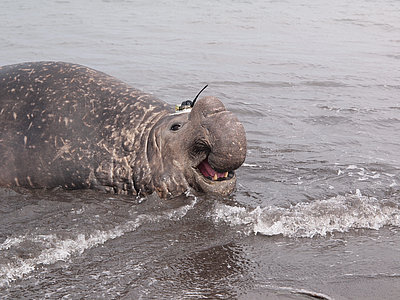
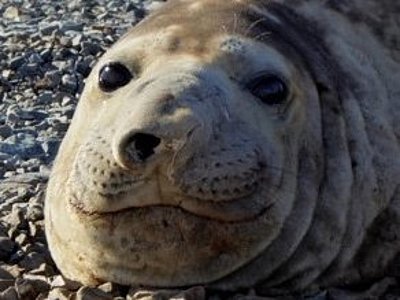
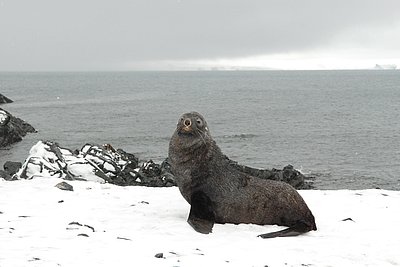
Arctocephalus gazella
The Antarctic fur seal can only be found on the islands of the Southern Ocean, and primarily south of the Antarctic Polar Front. On three groups of islands – the Prince Edward Islands, Crozet Islands and Macquarie Islands – it can be found together with the subantarctic fur seal (Arctocephalus tropicalis). The largest population is on South Georgia; numerous smaller populations have also been confirmed on Bouvet, Heard and McDonald Islands, as well as the Kerguelen, South Shetland, South Sandwich and South Orkney Islands. Fur seals have occasionally been observed on larger floes and pancake-ice floes (Bester et al., 2017). Female fur seals grow to ca. 1.45 metres in length and can weigh up to 50 kilogrammes; males grow up to 2 metres in length and can weigh up to 230 kilogrammes. Whereas females can live up to 23 years, for males the number is only 14 (Bester et al., 2017). Their population in the Southern Ocean is estimated at between 2 and 3 million. The young are born between late November and late December, in colonies. The Antarctic fur seal is an accomplished diver. Males dive at an average depth of 350 metres and remain underwater for up to 9 minutes, while females dive to ca. 200 metres and for only 4 minutes on average. Fur seals’ extended dives during the twilight hours are most likely an attempt to follow the vertical migration of their prey, which, depending on the region and season, can include various species of fish, squid and krill (Bester et al., 2017).
Bester M. N., H. Bornemann & T. McIntyre (2017): Antarctic marine mammals and sea ice. In: D. N. Thomas (ed.), Sea Ice, 3rd edition, Wiley-Blackwell, Chichester (UK) Hoboken (NJ), pp. 534-555
Hocking, D.P., A.R Evans, & E. M. G. Fitzgerald (2013): Leopard seals (Hydrurga leptonyx) use suction and filter feeding when hunting small prey underwater. Polar Biol 36, pp. 211–222 (2013). doi.org/10.1007/s00300-012-1253-9
Thomas, J. A & J. Terhune (2009): Weddell Seal: Leptonychotes weddellii. In: Perrin, W. F, B. Würsig & J.G.M. Thewissen (eds), Encyclopedia of Marine Mammals (Second Edition), Academic Press, 2009, pp. 1217-1220, ISBN 9780123735539, doi.org/10.1016/B978-0-12-373553-9.00278-9.
